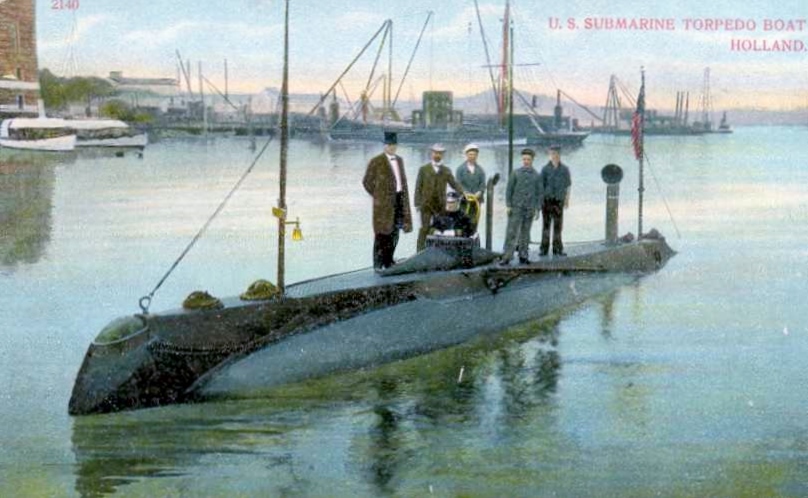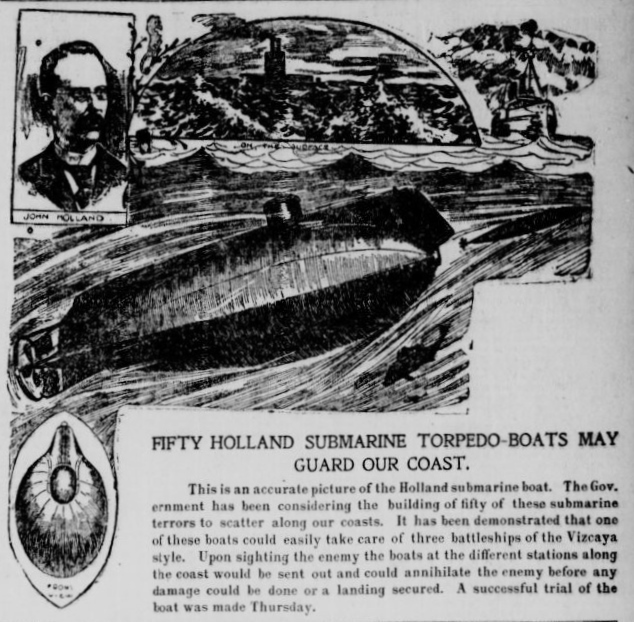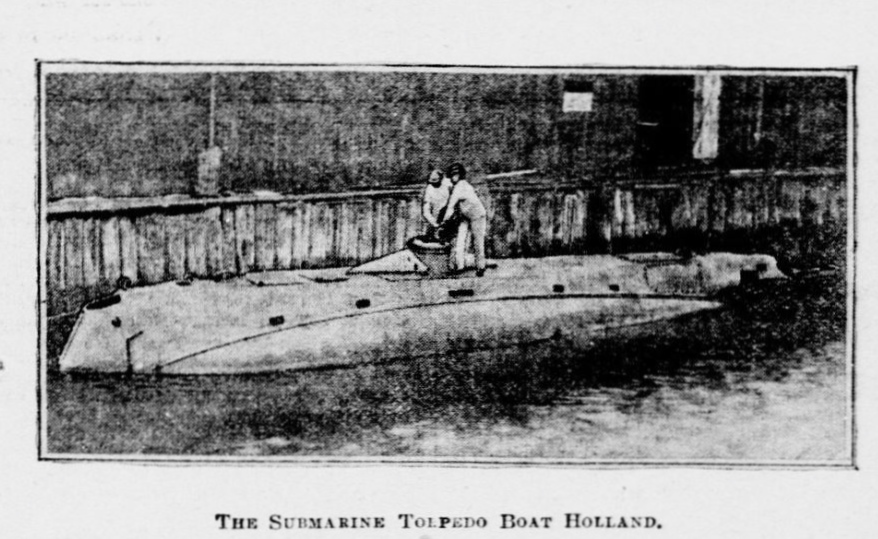The creation of a disordered mind
Centuries of dreams had surrounded the desire and even the need to conquer the underwater world. The industrial age brought with it many new inventions and ideas that were changing the world. The mastery of electricity and modern engines were just part of the growth that propelled man from the days of horse and buggy to more reliable methods of transportation. In 1900, one of the greatest challenges was met when an Irish immigrant named Holland fought through every challenge to create his submarine boat.
This story comes from the Richmond Virginia Paper and was dated April 1. There are dozens of stories in the Library of Congress Archives about the trials of the boat. This particular one opened a whole new window for me about some of the men who were involved. Of course, Holland’s story is pretty well known but one of the Navy men involved played a role that I had not been aware of. Captain John Lowe, United States Navy had a very instrumental role in the trials of the Holland boat. I will write more about him in a future article, but read his comments about the need for a future submarine force. In some ways, they are prophetic. In every way, they are accurate.
This story still focuses on John Holland, however. As a submariner, I have always been aware that to ride the boats requires a special ingredient that not all possess. Some call it courage. Some call it adventure. But frankly, there are probably more than a few that consider wanting to ride a boat built by the lowest bidder just a little crazy. Even for two dollars a day. How ironic that the man who finally came up with a winning solution to underwater warfare would be accused of having a “disordered mind”. That actually describes a lot of the men I admire most in life and spent time with below the dark ocean’s surface.
Holland Solved a Knotty Problem
The Times. (Richmond, Va.), 01 April 1900. Chronicling America: Historic American Newspapers. Lib. of Congress. https://chroniclingamerica.loc.gov/lccn/sn85034438/1900-04-01/ed-1/seq-11/
For many years the solutions of the problems of aerial and submarine navigation had remained unattainable und many scientists, the greatest of their days, have spent lifetimes in study, research and experiment, only to find at the end, that little or no progress had been made and the realization of their fondest hopes as far off as ever. These questions proved veritable “will-o’-the wisps,” until a few months ago, when one of the puzzling problems was found to no longer puzzle and what was heretofore regarded as unattainable was found to be obtainable. The problem of submarine navigation was solved.
It remained for an Irish school-teacher to evolve the formula. Years he had spent while in the Emerald Isle, in trying to find some means by which a boat could be made to rise or sink at will, and recognizing its almost inestimable value as a means of harbor defense and its formidable qualities as an enemy to an attacking or blockading fleet, he devoted all his powers and energies to solving the questions. He carefully computed the essentials of such a strange craft, and materials that could be most advantageously used in its construction. He had satisfied himself that such a strange boat could be constructed, and that its adoption by naval Powers would revolutionize the methods of modern warfare.
The rough plans were drawn and then laid away until the minor details of such an undertaking could be perfected.
Time, however, wrought the changes. Other matters demanded the attention of the pedagogue-inventor, and the consideration of the details of the submarine wonder was postponed from time to time. Finally the Irish school-teacher came to America and went to Boston, to visit his brother.
Here he met with an accident, which necessitated a long confinement to his bed. While bed-fast his mind again turned on the invention, the plan of which had for so long remained in an incomplete state. He had them brought to him and again worked out his calculations. On comparison with the old results, they were found identical. He took new hope and determined to put into actual test the theories that he had evolved. This he did.
THE INVENTOR’S TRIALS.
His efforts to interest those who were recognized as heads in the scientific world and leaders in advanced thought, and the authorities in naval construction were but the repetition of those of the great inventors that had preceded him, Ericson and his “cheese-box-on a-shingle,” Cyrus Field and his “crazy-cable,” were called to mind by him.
His “supposed sub-marine boat,” an impossibility, was pooh-poohed and ridiculed and laughed at by the great submarine and naval engineers. His plans were picked to pieces, flaws found at every turn, and his ideas declared “but the creation of a disordered mind.”
The inventor thought of the trials that had been the lots of Ericson, Field and others, and he like they, knew that pain, patience, and that indispensable quality, “everlastingly striking at it alone” were necessary to bring success. He had no fears as to the result.
Almost a decade ago in 1893, the Navy Department of the United States asked for the submission of plans for submarine boats. The “impossibility” was now beginning to be recognized as the “possible.” The Irish school-master took advantage of the opportunity and John P. Holland’s plans were accepted. Victory now seemed within his grasp.
The contract was awarded the Holland Torpedo Boat Company, of New York, and the work of building this “terror of the seas” was begun. She was completed a short time ago, and, after the most thorough trials, proved herself successful in every way.
CAPTAIN LOWE’S VIEWS.
The following is an extract from the report of Captain John Lowe, United States Navy:
“In obedience then to that part of my orders requiring me to submit a report of my observations, I submit the facts hereinbefore stated, and I report my belief that the Holland ¡s a successful and veritable Submarine Torpedo Boat, capable of making a veritable attack upon an enemy unseen and undetectable, and that, therefore, she is an Engine of Warfare of terrible potency which the Government must necessarily adopt into its service.
“Concerning the worse than worthlessness of the present above water Torpedo System, its methods, theories and appliances, the need for a deliverance from its absurdities and from the Fool’s Paradise of Its false security, and instead thereof the absolute need of a real torpedo system such as the Submarine System, I have already reported under date November 14, 1898
“In addition, however, I would like to give further reasons why a Submarine Service should at once be organized as a matter of public necessity and security.
“In the first place, we must concede that, notwithstanding the Hague Conference, the time has not yet arrived for nations to disarm; on the contrary. that nation which is not ready to fight, that ceases to study war; that ceases to use the most frightful warlike appliances when war is made, has already placed itself tin a position of inferiority and has ceased to possess those valuable attributes which are well described in the term Manhood. Such a nation is already in the position of China, a prey to the weakest and the most rapacious, and a disturbance to all the rest of mankind.
“If, then, we propose to fight, we must fight, when we fight, with every fighting appliance, and therefore, if there is anything valuable in Submarine Torpedo warfare, we must not permit our hands to be tied behind our bucks by any Hague Conference or pusillanimous humanitarianism forbidding such appliance.
WHAT WE MUST DO
“Again conceding war to be possible, consider where the United States is weak and how to resist attack.
“Let us not, ostrich-like, hide our eyes in the sand, but if we see danger let us look upon it.
“We have distant dependencies, the Philippines, Hawaii and the like. Will an enemy seek to bring us to terms by attacking these? Perhaps so. But if so, the move would be a weak one, exceedingly weak. In fact, we could afford to offer these as a Gambit, upon which the enemy could waste its strength, while we were developing counter moves.
“Let us not deceive ourselves. Any powerful enemy would not play at war after that fashion. They would strike us in the vitals. An eight-day dash across the Atlantic would bring their ships to Montauk Point, where they would encounter the American Fleet, which being destroyed by force of numbers, the remainder of the enemy’s ships could pass on and anchor in Long Island Sound in perfect security and very shortly Long Island would become a foreign possession.
“Do not consider the scheme a fanciful one. It is not original to my mind. So many have spoken of it, that I am satisfied it has been considered and digested in foreign councils und is part of their programme.
“Our last Spanish War convinced me that our own people were at that time awake to this fact, for we saw the Army diligently fortifying against what – Phantom ships!
“In our next war it won’t be Phantom ships, for there are at least two nations which can do this thing single handed.
“We need right off and right now 50 Submarine Torpedo vessels in Long Island Sound to preserve the peace and to give potency to our diplomacy.
“The French in this matter are much more alive to their needs than we are. What we have left to a private company the French have taken up as a National affair.
“Leaving out the Gymnote, of which I know but little, the French at the end of this year will have spent money and produced vessels as follows:
Gustave Zede……………..$ 586,181.00
Morse…………………………$ 166,483.00
Narval and class, 7 boats,…. $310,000.00
MISTAKES OF THE PLUNGER.
“It so happens, however, that the Zede is only a partial success (newspaper accounts to the contrary notwithstanding), and the Morse stall less so, while the Narval and class will be abject failures because of the same mistake made in our Plunger, a notable mistake which the Holland demonstrated in advance, and which mistake I understand is to be rectified.
“All the mistakes which have befallen the French will pass by our Government, notwithstanding the fact that instead of one and one-half million our Government has not spent one cent, nor has it bestowed anything more than scant encouragement upon the private company which has spent large amounts of money.
“Besides the mistakes saved, very many essential difficulties have been overcome which could not have been dreamed of at the outset, and as a consequence the Holland people by means of the Holland are in possession of ripe experience which the Government should possess, and no one else.
“Among the facts stated in the first part of my report, I have described the Holland Torpedo station and sketched the daily routine. I might observe that this Is precisely what the Government would do did it possess a station of the kind. It is also precisely the routine to be observed by a Torpedo Beat at sea, lying in wait for an enemy. That is to say, while motionless or in cruising trim, the batteries can be recharged and the air tanks filled ready for the approach of an enemy, until the fuel for the gas engine is nearly exhausted.
TO BIND OVER HOLLAND.
“It seems to me, therefore, quite a necessity that this Government should not allow this skill and knowledge to pass out of its own hands from Native to Foreign lands, but should forestall such a catastrophe by at once purchasing the Holland and putting the Holland people under some ban whereby they will be prevented from disclosing secrets to the disadvantage of the United States.
“How keenly Foreign Governments are alive to the Holland, I have shown ln my facts herein reported, concerning the presence of foreign officers upon her.
“Concerning future improvements to be made in the Holland and her successors, I confine myself to one example to show how much this point is a matter of opinion and not yet of knowledge.
“I desire to add my own opinion as to what the future policy of the Navy Department should be, after inaugurating a Submarine Service.”
HOLLAND’S THEORIES RIGHT.
The boat which bears the name of the inventor has proved a success. The submarine boat Plunger, which is now being overhauled at the Trigg yards, has not fulfilled expectations and has never lived up to her name. She was to be constructed after the same plans as the Holland, but changes were made by the Navy Department. Steam engines were put in and this proved to be the cause of all the trouble. Her motive power was to consist of three triple expansion engines, two showing 600 indicated horsepower, and one 300 horse power. The power was to be derived from high pressure water tube boilers. Mr. Holland objected to these modifications, declaring them impracticable, and that steam could not be installed as a power. The Department, however, refused to accept Mr. Holland’s plans and the Plunger is now being reconstructed after the inventor’s original plans. His objections proved to be well founded, for it was found, in actual test that when steam had been gotten up and the boat closed preparatory to diving, the heat was so intense that no human being would live on board, and in no way could the Plunger, as she stands now, have fulfilled any of the demands made on her as regards to diving and recovery. After her complete, overhauling and renovation the Plunger will be a prototype of the Holland, and the correctness of the Irish school-master’s theories, as to submarine navigation, once more be demonstrated.
There is more to this story… Captain Lowe is a fascinating figure in American History and will be covered in more detail in the next post.
One tease: even though many men had sailed on previous versions of submersibles, he is the very first Naval Submarine Officer. I’ll leave you with that for now.
Mister Mac




Reblogged this on theleansubmariner and commented:
Happy Submarine Month… another one of the stories about Holland